
Inside the 196-km Delhi Metro, trains carry 2-million passengers daily through 142 stations and each train creates an incredible amount of wind that students at Delhi University are hoping to harness. Ten students from the university have a plan to install a small wind turbine to generate electricity inside the Metro system.
Students hope to generate 200 watts per hour with a single generator, which is no where near the overall power consumption of the system. Nonetheless, this marks and incredible innovation towards finding new ways to generate energy in cities.
Currently, Delhi Metro is in phase III of a major transit overhaul. Once the project is complete by 2020, the Delhi system will be the fourth largest in the world with 420 km of lines.
Via Clean Technica
Urban Planet is a roundup of blogs from around the world dealing specifically with urban environments. For more stories from around the planet, check out Spacing on Facebook and Twitter.


7 comments
Ummm… That energy just comes from the trains pushing wind down the tunnel. If you slow down that wind by capturing it with a wind turbine, doesn’t that just mean that the trains have to push (ever so slightly) harder? It’s not free energy.
The ‘wind’ in the subway tunnel is air being displaced (pushed) by the movement of the subways. Placing windmills in the subway system to capture energy from the moving air will increase the resistance of the air to being displaced, causing the subway trains to expend more energy in moving through the system. There is no free lunch.
These students should go back to basic physics principles. Presumably the trains would have to work harder if there were any impediment to wind exiting the tunnels through grates etc., such as a turbine to generate the power. There’s no free lunch (it’d be like trying to cool a room by opening the refrigerator door)!
I think they would have more luck capturing the energy from all of those people walking through the stations.
Maybe the wind turbine can collect energy which is originally wasted due to the unstable flow. In such case the conservative law still works and the train doesn’t need more energy pushing the air.
Just curious – aren’t these trains trying to slow down anyway? The majority of wind power would be generated when a train travelling at full speed approaches / enters a subway, at which point it is actually trying to reduce its momentum – adding wind turbines at the entry point to the subway could assist in the deceleration while collecting energy that would otherwise be turned into heat (by the brakes).
Somehow generating enough power to light two 100-Watt bulbs seems hardly worth the investment. The big savings is in regenerative braking for the subway, which I imagine they have in place already.